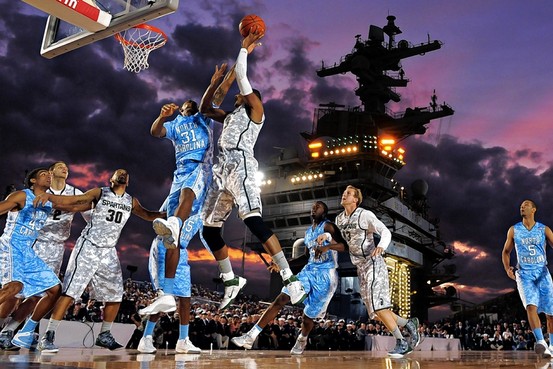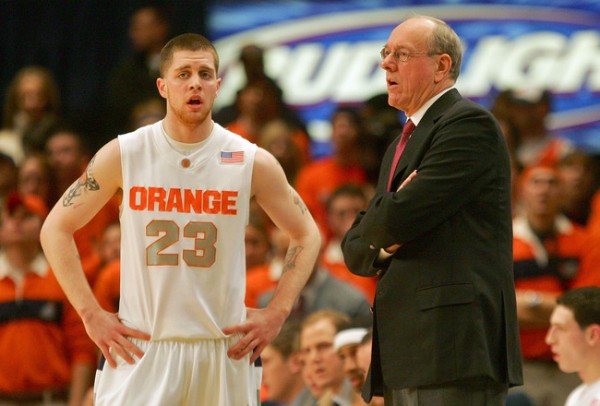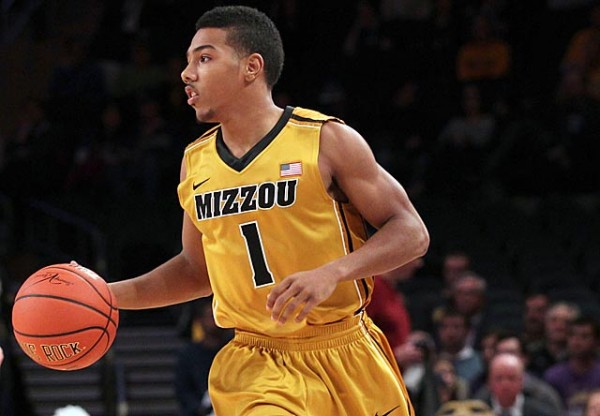Trick or Treat: RTC Hands Out Its Halloween Goodies
Posted by Chris Johnson on October 31st, 2012Chris Johnson is an RTC Columnist. He can be reached @ChrisDJohnsonn.
At this time of year, when the visible signs of Autumn truly take form, you know two things. The first is that actual college basketball games are upon us. Not just speculation and hearsay; the game itself, the basis for all that hype and buildup, is right around the corner. Then there’s Halloween, the consummate Fall holiday, promising a bounty of tricks and treats for costumed children nationwide. Though you’ve most likely outgrown the days of door-to-door candy voyages and late night sugar binges, the last day of October still has meaning. College basketball deserves a place in the festivities, too. Like all Halloweens, you can’t mention confectionery tweets and scary costumes without trickery and mischief. After all, there is a separate holiday for that. To hit both sides of the coin, we’re bringing five tricks and five treats to our favorite teams, players, coaches, places and whatever else can be boxed into the college hoops realm. The mixed bag features a random compilation of offseason developments (both good and bad), preview-centric topics and some of the biggest storylines as we approach this season’s opening tipoff. As the bombardment of polls, rankings and All-America teams from various media outlets continues, consider this a refreshing tweak on your annual preseason college hoops diet. And I can promise you this: Much like your Halloweens of old, the pillow bags teeming with your favorite comestibles, this here holiday treat will not lack for taste. Though to maximize your Halloween satisfaction, consume this savory treat in tandem with a hearty serving of the real-life version (and make sure to stay clear of the tricks) – satisfying your palette, and your thirst for college basketball. There are few better ways to do Halloween.
Five Treats to be delivered upon… 1. The Hive Minds of Patriotic Scheduling.
The 2011 Carrier Classic will go down as one of the most memorable non-conference games in recent history (photo credit: AP)
Last season’s Carrier Classic played aboard the USS Carl Vinson was a spectacular way to christen the 2011-12 season. It featured two brand-name programs (Michigan State and North Carolina) and two coaching legends competing before a backdrop of gorgeous vistas, with a uniform-clad naval crowd and President Obama taking in the proceedings. More importantly, it captured some of the national sports attention usually reserved for football this time of the year and sparked a minor interest in the college hoops non-conference season. The shipside fun will come at you threefold this season, with Ohio State-Marquette, Syracuse-San Diego State and Florida-Georgetown all playing November 9 games on military vessels. But this year’s non-conference slate is outdoing last year’s offering: Michigan State will begin its season with a game against Connecticut at the Ramstein Air Force base in Germany. MSU AD Mark Hollis, we salute you.
2. NCAA Reform.
Since taking over as NCAA president in 2010, Mark Emmert has presided over an organization riddled with nonstop criticism. Most complaints attack the NCAA’s infractions committee, its obscure and inconsistent punishment guidelines, and the pace of its proceedings. Through it all, Emmert voiced his desire to pass NCAA reform. On Tuesday, his vision was realized. Among other streamlined legislative tweaks, the new four-tier penalty structure places a greater responsibility on coaches to police their respective teams. It also helps clarify and distinguish the parameters dictating violations and punishments, meaning we’re likely to have a better sense of the previously muddled relationship between violation classification and punitive severity. We’ve always wanted clarity, and now it’s here. This applies to all college sports, but for college basketball in particular, where recruiting violations and agent activity run rampant, the rule changes are a decided proactive move.
3. The Big Ten.
Any ranking of college hoops conferences mixes two competing parameters: top-to-bottom depth and top-tier strength. For this year’s Big Ten, use whatever measure you’d like because this conference is the best in the country, and it should produce one of the most exciting league races we’ve seen in years. Michigan, Ohio State and Indiana all have credible designs on a conference title. All three return major pieces from last season, and all three were represented in this season’s preseason AP All-America team (the only major conference players to make the cut). The rest of the league is brimming with talent, experience and coaching quality, from Minnesota to Michigan State to Wisconsin, and many more. In the end, the teams will beat each other up during league play, but the league could produce as many as eight Tournament berths. My prediction? Preseason No. 1 Indiana will not live up to its considerable hype, and Michigan will finish ahead of the pack, with Ohio State falling one game short.
4. The Teams Bringing in Big Transfers.
You can’t always count on freshmen to step in and contribute in huge roles the moment they step on campus. Not everyone is Anthony Davis and Michael Kidd-Gilchrist. Coaches have found a new way to fill out their rosters: transfers. This year’s batch carries enormous conference and national championship implications. Missouri alone welcomes in four transfers. UNLV brings in the No. 1-ranked center in the class of 2011, Khem Birch, who left Pittsburgh after just 10 games under an ominous cloud of attitude concerns. Arizona welcomes embattled former Xavier guard Mark Lyons into the fold. These are big name players joining big-name programs, with each offering a unique on-court variable to their teams and systems. When you take that kind of star power and shuffle it around to new leagues and coaches, the end result is unpredictable, and that’s exactly what makes these inter-team swaps so tantalizing.

It’s important to enjoy the Orange and Panthers’ last season in the Big East, for the league will never be the same without them (Photo credit: Getty Images)
5. Pittsburgh’s and Syracuse’s Last Season in the Big East.
One year from now, prepare for an overwhelming wave of anticipation and giddiness from ACC fans and media over the impending arrivals of Pittsburgh and Syracuse. For years these two programs embodied Big East hoops, competed for conference and regular season titles, and regularly inhabited its competitive upper-echelon. The Orange and Panthers defined the bruising halfcourt style the league hangs its hat on, a style set in flux by the new members joining the league over the next three seasons. As replacements go, Memphis and Temple are valuable additions; it’s about as as successful as any realignment contingency plan ever could be. But the halcyon days of Boeheim and Thompson, of Devendorf and six OTs at the Garden, of LeVance Fields’ awkward but oddly effective offensive style, are forever lost. And for that, we are ashamed. Blame football, blame TV money – the harsh reality is set in stone. In one year, the Big East will carry on without two of its flagship programs. So make sure you catch as many Syracuse and Pittsburgh games as you can. Savor the Orange’s 2-3 zone and the always geeked-up Oakland Zoo, for in one year’s time, there will be no mistaking the absence of these two league heavyweights.
Five Tricks to be delivered upon… 1. The NCAA’s Still Unreformed Enforcement Process.The perfect subtext to my NCAA-related treat: The eligibility uncertainty looming over Shabazz Muhammad and Kyle Anderson. The organization’s review of the two players, which began this summer after questions were raised of possible impermissible benefits accepted during Muhammad’s and Anderson’s respective recruitments, remains unresolved. For the many UCLA fans hoping for a basketball rebirth to go along with a revamped Pauley Pavilion and No. 1 recruiting class, this is something of a concern. Actually, it’s more than that. It’s a season-altering development. Without Muhammad and Anderson, the Bruins are an average team, only marginally improved from last season’s 19-14 squad. With them, they are a national title contender. It’s unlikely either player will miss the entire season, but not having them around, if only for the first couple months of the season, will strain UCLA’s early season development, the collective growth and feeling-out period that precedes conference play. The NCAA should have this figured out by now, lest Bruins fans, coaches and players fear the prospect of a season without their freshmen stars.
2. Wisconsin’s Injury Misfortune.
It’s easy to undersell Wisconsin most years. They play a boring, defense-first style, are typically restricted to mid-level recruits (Sam Dekker, top-five forward in the class of 2012, is an exception), and mostly proceed with a relatively low profile. I fully expect the Badgers to finish near the top of the Big Ten this season, with at the very least one NCAA Tournament win in tow. But I have to admit, the news out of Madison over the past two weeks gives me pause. Not only did the Badgers lose starting forward Mike Bruesewitz for the first six weeks of the season due to a serious leg laceration – the description of which, if you’re up for it, is gruesome — starting point guard Josh Gasser will miss the entire season after suffering a torn anterior cruciate ligament in practice Saturday. As Wisconsin sets to begin their season without 40 percent of its starting lineup, one thing is clear: freshman Dekker will put his five-star ranking on the line from day one.
3. The RPI.
The counterargument for common RPI screeds is simple and easy. The NCAA says it considers many components of a team’s tournament resume – not just the crude and completely malleable Ratings Percentage Index. That may be true, but all indications point towards the RPI ruling the annual selection deliberations. The committee’s use of the metric has become so predictable that coaches are letting the RPI formula dictate the schedule-building process, and doing so to great effect. Which totally makes sense! If the selection committee is going to put so much weight in one basic metric, why not create a schedule designed to maximize your RPI ceiling? This wouldn’t be an issue if the NCAA used a more comprehensive set of rankings and statistics to assess tournament resumes. For something as pivotal as the NCAA Tournament, where the bubble cut often serves as a de facto job-saving credential, the process of choosing teams should be as accurate and open as possible. This is not a new complaint – people have been wringing their hands over the RPI for years – it simply needs to be reinforced. And I didn’t want to wait until March to vent my frustration.
4. The Border War.
Over the past three years, conference realignment has left a mixed imprint on college basketball. For the most part, the ongoing wheel of change has proceeded with a singular focus, often neglecting territorial ties or scholastic pertinence, severing rivalries and league equity. The casualties were numerous and wide-ranging, though there were few more distressing than the end of The Border War, the decades-old feud between Missouri and Kansas. This heated series began before the Civil War, when guerrilla warfare between the states ignited a natural state-bound antagonism. The animosity carried on for 105 years, and the hate was at its unbridled best on the basketball court. Unfortunately, with Missouri bolting for the SEC this season, we have seen the last of a self-imposed Border War (we can still hope the NCAA Selection Committee has a sense of humor). It’s a huge blow to college basketball’s competitive appeal – and doubly so in light of last season’s two thrilling renditions of the Mizzou-KU battle, which were decided by a combined four points and gave the series two climactic finish to cap its long and storied history. Unless the Jayhawks and Tigers rekindle their hostilities in a non-conference setting, then one of the sport’s best rivalries will lamentably perish.
5. Calipari Cynics.
I’ll keep this short, because any defense of John Calipari and his coaching methods runs the chance of breaking off into 3,000-word territory. The Calipari hate was louder than ever before this offseason, when the Kentucky coach led Anthony Davis, Michael Kidd-Gilchrist and a host of talented complementary players to a national championship. He debunked longstanding precepts about the fundamental necessities of veteran leadership and freshmen experience and seniors’ crucial roles in Tournament play. It made a lot of people really, really angry. It’s time to reconsider that stance (though if you’re a truly anti-Calipari hardliner, you’ve probably stopped reading by now). Calipari is not going away, so the basketball machine he oversees in Lexington will keep reeling in five-star talent and keep competing at the highest levels of the sport. Rather than waste your time criticizing his model, learn to accept it and realize that Calipari, just like every other coach, operates on a level competitive playing field – the difference is that Calipari has learned how to maximize it. Any criticism against his ability to take top high school players, leverage their NBA talents into high-win outfits and repeat the process year after year is derived more in jealousy than actual spite. Because if your favorite coach or team could replicate Calipari’s system, you best believe you’d embrace the rewards – the wins, the tournament success, the connections to hip-hop moguls, the center stage of the college hoops universe, and so on – and ask questions later.














































